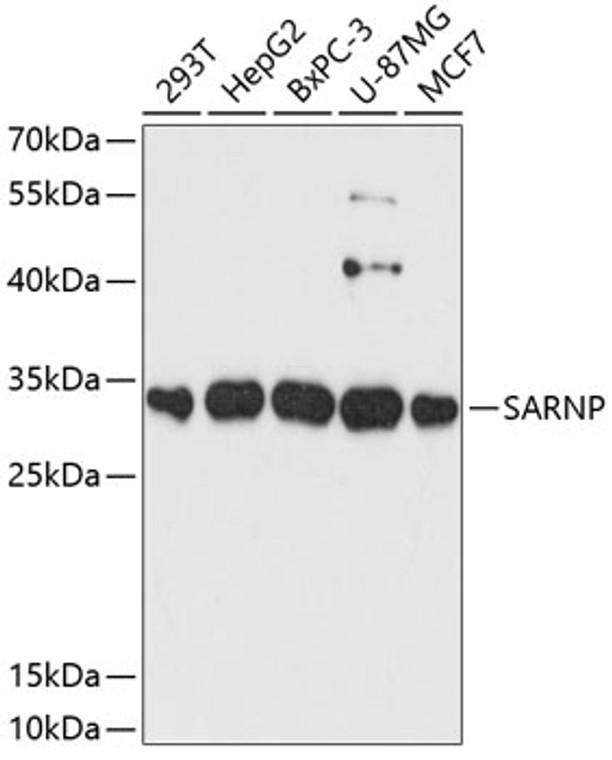| Host: |
Rabbit |
| Applications: |
WB/IHC/IF |
| Reactivity: |
Human |
| Note: |
STRICTLY FOR FURTHER SCIENTIFIC RESEARCH USE ONLY (RUO). MUST NOT TO BE USED IN DIAGNOSTIC OR THERAPEUTIC APPLICATIONS. |
| Short Description: |
Rabbit polyclonal antibody anti-SARNP (1-210) is suitable for use in Western Blot, Immunohistochemistry and Immunofluorescence research applications. |
| Clonality: |
Polyclonal |
| Conjugation: |
Unconjugated |
| Isotype: |
IgG |
| Formulation: |
PBS with 0.01% Thimerosal, 50% Glycerol, pH7.3. |
| Purification: |
Affinity purification |
| Dilution Range: |
WB 1:500-1:2000IHC-P 1:50-1:200IF/ICC 1:50-1:200 |
| Storage Instruction: |
Store at-20°C for up to 1 year from the date of receipt, and avoid repeat freeze-thaw cycles. |
| Gene Symbol: |
SARNP |
| Gene ID: |
84324 |
| Uniprot ID: |
SARNP_HUMAN |
| Immunogen Region: |
1-210 |
| Immunogen: |
Recombinant fusion protein containing a sequence corresponding to amino acids 1-210 of human SARNP (NP_149073.1). |
| Immunogen Sequence: |
MATETVELHKLKLAELKQEC LARGLETKGIKQDLIHRLQA YLEEHAEEEANEEDVLGDET EEEETKPIELPVKEEEPPEK TVDVAAEKKVVKITSEIPQT ERMQKRAERFNVPVSLESKK AARAARFGISSVPTKGLSSD NKPMVNLDKLKERAQRFGLN VSSISRKSEDDEKLKKRKER FGIVTSSAGTGTTEDTEAKK RKRAERFGIA |
| Tissue Specificity | Low expression in spleen, liver, pancreas, testis, thymus, heart, and kidney. Increased levels are seen in hepatocellular carcinoma and pancreatic adenocarcinoma. |
| Function | Binds both single-stranded and double-stranded DNA with higher affinity for the single-stranded form. Specifically binds to scaffold/matrix attachment region DNA. Also binds single-stranded RNA. Enhances RNA unwinding activity of DDX39A. May participate in important transcriptional or translational control of cell growth, metabolism and carcinogenesis. Component of the TREX complex which is thought to couple mRNA transcription, processing and nuclear export, and specifically associates with spliced mRNA and not with unspliced pre-mRNA. TREX is recruited to spliced mRNAs by a transcription-independent mechanism, binds to mRNA upstream of the exon-junction complex (EJC) and is recruited in a splicing- and cap-dependent manner to a region near the 5' end of the mRNA where it functions in mRNA export to the cytoplasm via the TAP/NFX1 pathway. The TREX complex is essential for the export of Kaposi's sarcoma-associated herpesvirus (KSHV) intronless mRNAs and infectious virus production. |
| Protein Name | Sap Domain-Containing RibonucleoproteinCytokine-Induced Protein Of 29 KdaNuclear Protein Hcc-1Proliferation-Associated Cytokine-Inducible Protein Cip29 |
| Database Links | Reactome: R-HSA-159236Reactome: R-HSA-72187Reactome: R-HSA-73856 |
| Cellular Localisation | NucleusNucleus Speckle |
| Alternative Antibody Names | Anti-Sap Domain-Containing Ribonucleoprotein antibodyAnti-Cytokine-Induced Protein Of 29 Kda antibodyAnti-Nuclear Protein Hcc-1 antibodyAnti-Proliferation-Associated Cytokine-Inducible Protein Cip29 antibodyAnti-SARNP antibodyAnti-HCC1 antibodyAnti-HSPC316 antibody |
Information sourced from Uniprot.org
12 months for antibodies. 6 months for ELISA Kits. Please see website T&Cs for further guidance









